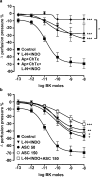Requirement for flow in the blockade of endothelium-derived hyperpolarizing factor (EDHF) by ascorbate in the bovine ciliary artery
- PMID: 15237098
- PMCID: PMC1575176
- DOI: 10.1038/sj.bjp.0705816
Requirement for flow in the blockade of endothelium-derived hyperpolarizing factor (EDHF) by ascorbate in the bovine ciliary artery
Abstract
We previously reported that ascorbate inhibits endothelium-derived hyperpolarizing factor (EDHF)-mediated vasodilatation in the bovine perfused ciliary circulation and rat perfused mesentery, but not in rings of bovine or porcine coronary artery. In this study, we have compared the ability of ascorbate to inhibit EDHF-mediated vasodilatation in a single vessel, the bovine long posterior ciliary artery, when perfused and when mounted as rings in a myograph. Both in segments perfused at a flow rate of 2.5 ml min(-1) and in rings mounted in a myograph, bradykinin and acetylcholine each induced vasodilator responses that were mediated jointly by EDHF and nitric oxide, as revealed by their respective blocking agents, apamin/charybdotoxin, and L-NAME. Ascorbate (50 and 150 microm) induced a time (max at 2-3 h)-dependent inhibition of the EDHF-mediated component of vasodilatation to bradykinin or acetylcholine in perfused segments, but not in rings. Ascorbate (50 microm) failed to inhibit bradykinin-induced vasodilatation at a flow rate of 1.25 ml min(-1) or below, but produced graded blockade at the higher flow rates of 2.5 and 5 ml min(-1). Furthermore, using a pressure myograph where pressure and flow were independently controlled, it was confirmed that the inhibitory action of ascorbate (150 microm) was directly related to flow per se and not any associated changes in pressure. Thus, we have shown in the bovine ciliary artery that ascorbate inhibits EDHF-mediated vasodilatation under conditions of flow but not in a static myograph. The mechanism by which flow renders EDHF susceptible to inhibition by ascorbate remains to be determined.
Copyright 2004 Nature Publishing Group
Figures






Similar articles
-
Flow-induced enhancement of vasoconstriction and blockade of endothelium-derived hyperpolarizing factor (EDHF) by ascorbate in the rat mesentery.Br J Pharmacol. 2008 Mar;153(6):1162-8. doi: 10.1038/sj.bjp.0707499. Epub 2007 Oct 8. Br J Pharmacol. 2008. PMID: 17922023 Free PMC article.
-
Differential effects of ascorbate on endothelium-derived hyperpolarizing factor (EDHF)-mediated vasodilatation in the bovine ciliary vascular bed and coronary artery.Br J Pharmacol. 2003 Mar;138(6):1172-80. doi: 10.1038/sj.bjp.0705143. Br J Pharmacol. 2003. PMID: 12684274 Free PMC article.
-
Ascorbate blocks endothelium-derived hyperpolarizing factor (EDHF)-mediated vasodilatation in the bovine ciliary vascular bed and rat mesentery.Br J Pharmacol. 2002 Apr;135(7):1801-9. doi: 10.1038/sj.bjp.0704623. Br J Pharmacol. 2002. PMID: 11934822 Free PMC article.
-
Endothelium-derived hyperpolarizing factor in vascular physiology and cardiovascular disease.Atherosclerosis. 2009 Feb;202(2):330-44. doi: 10.1016/j.atherosclerosis.2008.06.008. Epub 2008 Jun 20. Atherosclerosis. 2009. PMID: 18656197 Review.
-
Endothelium-derived hyperpolarizing factor: a key mediator of the vasodilator action of bradykinin.Immunopharmacology. 1996 Jun;33(1-3):46-50. doi: 10.1016/0162-3109(96)00083-5. Immunopharmacology. 1996. PMID: 8856114 Review.
Cited by
-
Flow-induced enhancement of vasoconstriction and blockade of endothelium-derived hyperpolarizing factor (EDHF) by ascorbate in the rat mesentery.Br J Pharmacol. 2008 Mar;153(6):1162-8. doi: 10.1038/sj.bjp.0707499. Epub 2007 Oct 8. Br J Pharmacol. 2008. PMID: 17922023 Free PMC article.
-
Oxidation by trace Cu2+ ions underlies the ability of ascorbate to induce vascular dysfunction in the rat perfused mesentery.Eur J Pharmacol. 2009 Jul 1;614(1-3):84-90. doi: 10.1016/j.ejphar.2009.04.033. Epub 2009 Apr 24. Eur J Pharmacol. 2009. PMID: 19394330 Free PMC article.
References
-
- BAUERSACHS J., POPP R., HECKER M., SAUER E., FLEMING I., BUSSE R. Nitric oxide attenuates the release of endothelium-derived hyperpolarising factor. Circulation. 1996;94:3341–3347. - PubMed
-
- BOO Y.C., JO H. Flow-dependent regulation of endothelial nitric oxide synthase: role of protein kinases. Am. J. Physiol. Cell Physiol. 2003;285:C499–C508. - PubMed
-
- BUSSE R., FLEMING I. Regulation of endothelium-derived vasoactive autacoid production by hemodynamic forces. Trends Pharmacol. Sci. 2003;24:24–29. - PubMed
-
- CAMPBELL W.B., HARDER D.R. Prologue: EDHF – what is it. Am. J. Physiol. 2001;280:H2413–H2416. - PubMed
-
- CARR A.C., ZHU B.Z., FREI B. Potential antiatherogenic mechanisms of ascorbate (vitamin C) and alpha-tocopherol (vitamin E) Circ. Res. 2000;87:349–354. - PubMed
Publication types
MeSH terms
Substances
LinkOut - more resources
Full Text Sources
Medical
Miscellaneous

